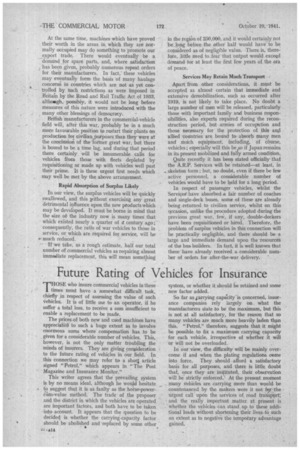Future Rating of Vehicles for Insurance
Page 16

If you've noticed an error in this article please click here to report it so we can fix it.
'"1"HOSE who insure commercial vehicles in these times must have a somewhat difficult task, chiefly in respect of assessing the value of such Vehicles. It is of little use to an operator, if he suffer a total loss, to receive a sum insufficient to enable a replacement to be made.
The prices of both new and used machines have appreciated to such a huge extent as to involve enormous sums where compensation has to be given for a considerable number of vehicles. This, however, is not the only matter troubling the minds of insurers. They are giving consideration to the future rating of vehicles in our field. In this connection we may refer to a short article signed "Petrol," which appears in "The Post Magazine and Insurance Monitor."
This writer agrees that the prevailing system is by no means ideal, although he would hesitate _ • to suggest that it is as faulty as the horse-poweram-value method. The trade of the proposer and the district in which the vehicles are operated are important factors, and both have to be taken into account. It appears that the question to be decided is whether the carrying-capacity factor should be abolished and 'replaced by some other system, or whether it should be retained and some new factor added.
So far as tarrying capAity is concerned, insurance companies rely largely on what the manufacturers state to be the maximum, but this is not at all satisfactory, for the reason that so many vehicles are much more heavily laden than this. "Petrol," therefore, suggests that it might be possible to fix a maximum carrying capacity for each vehicle, irrespective of whether it will or will not be overloaded.
In Our view, the difficulty will be mainly overcome if and when the plating regulations come into force. They should afford a satisfactory basis for all purposes, and there is little doubt that, once they are in4ituted, their observation will be strictly enforced.' At the present moment many vehicles are carrying more than would be .countenanced by the makers were it not fe,r the urgent call upon the services of, road transport; and the really important matter at present is whether 'the vehicles can stand, up to these additional loads without shortening their lives to such an extent as to negative the tempotary advantage gained.




















































